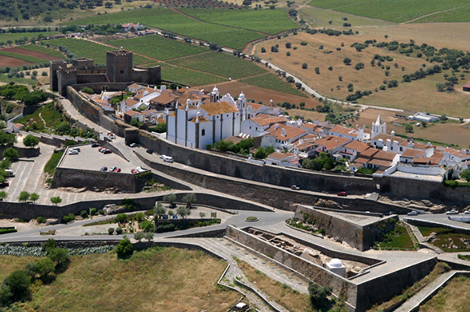Municipality of Reguengos presents program commemorating 500 years of Foral Manuelino de Monsaraz
The City Council of Reguengos de Monsaraz will celebrate the 500th anniversary of the Foral Manuelino de Monsaraz. The annual program […]

The City Council of Reguengos de Monsaraz will celebrate the 500th anniversary of the Foral Manuelino de Monsaraz. The annual program of commemorations will be presented on Saturday, January 28, at 16:30 pm, at the Igreja de Santiago, in Monsaraz.
This ceremony will also include the technical presentation of the conservation works carried out in the Clock Tower (a monument built at the end of the XNUMXth century or beginning of the XNUMXth century), by the architect José Filipe Ramalho, and the donation of the estate of the historian José Pires will be signed. Gonçalves, who studied and provided knowledge of the archaeological heritage of the municipality of Reguengos de Monsaraz.
The regional director of Culture Aurora Carapinha and the historian and author of the novel “As Horas de Monsaraz”, Sérgio Luis de Carvalho, who will present a communication about the Clock Tower, will participate in the presentation session of the Foral Manuelino de Monsaraz commemorative program. .
In the historical novel published in 1997 by the publisher Campo das Letras, the author goes back to the distant date of 1562, when a judge seeks to restore some of its former prestige and monumentality to the old fortress.

To do this, he decides to build a tower with a clock. However, the action had different reactions that led to rivalries among the residents of Monsaraz: for the local bourgeois and merchants, “earthly” men, the tower would be a “symbol of urban pride”, but for the vicar of the village it would go against nature , paced by the seasons, in which the “divine” men saw each other.
In this session, poems by Manuel Sérgio will also be recited and the Grupo Coral da Freguesia de Monsaraz will act.
On June 1st, 500 years have passed since King Manuel I granted a new charter in Lisbon to the town of Monsaraz to replace the old Foral Afonsino (attributed by King Afonso III in 1276).
On this date, the delivery of the charter to the mayor will be recreated, the launch of the facsimile edition of the Foral Manuelino will take place and there will be a concert commemorating the anniversary.
The program also includes the exhibition “Monsaraz na História”, which will be on display at the Church of Santiago from May 1st to June 30th, as well as the opening of the Fresco Museum, which will take place on July 13th.
In this museum you can appreciate the Fresco do Bom e Mau Juiz, painting from the end of the 1958th century and discovered in XNUMX that represents the allegory of earthly justice, in which the good and the bad judge are the main elements and that evidence the traditional formulas of human exemption and corruption.
Also on July 13, the project for the recovery of the Alquerque Game will be presented, which was played in ancient Egypt for over 3 years and was introduced in Europe in the XNUMXth century by Muslims.
This game, ancestor of the current Checkers Game, is represented on several slabs scattered throughout the medieval town of Monsaraz and the municipality intends to produce replicas and organize a tournament during the summer.
The Foral Manuelino de Monsaraz commemorative program also includes, in July, a nocturnal astronomy observation session on the evolution of the celestial map over the last 500 years.
On October 6th, the Monsaraz Interpretive Center will be presented to the public, which will operate at the Casa da Inquisition.
About the Charter of Monsaraz

On June 1, 2012 marks 500 years since King Manuel I granted a new charter to the town of Monsaraz to replace the old Afonsino charter attributed in 1276 by King Afonso III, written in Barbaric Latin and already to time in a poor state of conservation and difficult to read and interpret by officials of the Chamber.
This reformist movement began in May 1496, when the monarch appointed a commission that, over the next two decades, proceeded to collect all existing documentation in the Kingdom – privileges and old charters – reformulating it according to a certain systematization in the so-called “Forais Novos” (or Manuelinos).
With this reform, gigantic for the time, the king intended to achieve two objectives: on the one hand, normalize, as much as possible, the rights and duties of landlords and landlords and, on the other, correct the abuses and adulterations with which the landlords administered their domains.
The Foral de Monsaraz (possibly a copy made in the XNUMXth century) is a parchment document (animal skin) and manuscript in dark ink, bound with a leather-covered wooden cover, flanked by the armillary spheres that center the coat of arms of the royal arms .
It is known that three copies of the charters of this kind were made and thus, one of them was that of Torre do Tombo (registry book), another that of the grantee (in this case, the Casa de Bragança) and the third that of the respective Town Hall .
The copy that currently exists in the Museum of Sacred Art, in Monsaraz, was acquired in June 1927 by the Mayor of Reguengos de Monsaraz, Braz Garcia da Costa, who bought it for 1.500 escudos from a private person who lived in Évora.
Later, in February 1949, José Garcia da Costa definitively donated it to the Parish Museum of the Church of Nossa Senhora da Lagoa.